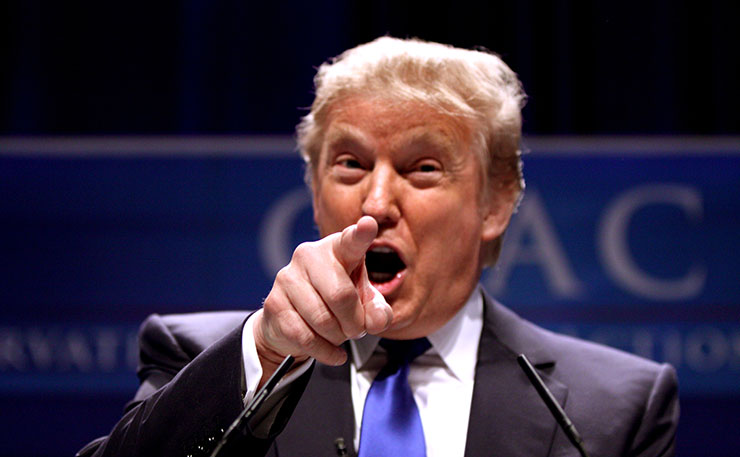The Republican candidate managed to drag across blue collar voters, and Clinton won less votes from women than Obama did in 2012. Michael Brull crunches the numbers on an election that has already changed the world.
The victory of Donald Trump is catastrophic. Four years of a President who thinks climate change is a hoax. That he also wants to cut taxes and regulations on the super-rich may well mean that the planet will be cooked. Perhaps climate catastrophe will be averted by nuclear war; a risk which is impossible to gauge under Trump.
Everyone on the planet should feel anxious about Trump’s victory: this may be the end of all of us.
There is very little dispute on the Left about the awfulness of Trump’s victory. The area of dispute mostly comes from the centre-left, who have reacted with bewilderment. How on earth could they elect Trump?
It is that question which I think it is important that we face honestly and squarely.
In my previous analysis, I argued that crucial factors of Trump’s win included anti-establishment sentiment, declining support for the Democrats, and the class grievances of working class white workers in the Rust Belt.
Since then, more information on Trump’s victory has come out. I think it makes clear that these trends were crucial to Trump’s win.
Sick of the establishment
Exit polls of voters in a way present their own bias. They reflect the views of Americans who thought that voting was actually worthwhile, as opposed to those who were too disillusioned or disinterested to think it worth voting for either candidate.
With that bias in mind, consider the exit poll of 10,000 voters by Reuters/Ipsos. Of those who voted, 72 per cent agree “the American economy is rigged to advantage the rich and powerful”. 68 per cent agreed that “traditional parties and politicians don’t care about people like me”. 76 per cent agreed that “the mainstream media is more interested in making money than telling the truth”. And 75 per cent thought that “America needs a strong leader to take the country back from the rich and powerful”.
Now consider New York Times polling on voters.
When asked about the most important candidate quality, 83 per cent of Trump voters thought Trump could “bring needed change”. Only 14 per cent said Clinton was that candidate. When it came to who “Has the right experience”, 90 per cent said Clinton.

In a sense, this was straightforward enough. Trump constantly trashed the establishment and elites; Clinton bragged about her experience and qualifications. Yet when so much of the public was so sick of the status quo, Clinton’s “experience” really meant that she was regarded as an insider.

It is also important to note how they described their votes. Of those who “strongly” supported their candidate, this only accounted for 42 per cent of Trump voters. 49 per cent of them had reservations, and 51 per cent disliked the other candidates. Most Trump fans weren’t that enthusiastic about him – and only a little more than half of Clinton’s supporters thought she was that great either. Only 35 per cent of Trump voters agreed that he “Cares about people like me”.
Now consider the financial situation of voters. Those whose situation had improved as compared to 2015 mostly backed Clinton, with 72 per cent backing her over 24 per cent for Trump. As for those worse off, 78 per cent backed Trump.

Yet the way this played out is also significant. About half of voters said the most important issue was the economy, and 42 per cent of them backed Trump, versus 52 per cent for Clinton. Yet for the 13 per cent who worried about immigration, 64 per cent backed Trump, and for 18 per cent who worried about terrorism, 57 per cent backed Trump. That is, people who worried about their declining financial situation didn’t necessarily look to Trump to fix the economy. Though voters were likely to want change, they thought Trump should focus on terrorism, or immigration.
To that extent, Trump’s racist demagogy was effective for elements of the coalition of supporters he assembled. Yet the fact is that his voters didn’t overwhelmingly fixate on any particular issue. They simply trusted the strong man to solve their problems. And trust may be a strong word, because less than half gave particularly strong support to Trump.
Decline of the Democrats
Many liberals have no idea why so many people didn’t like Clinton. They responded to criticisms from Bernie Sanders and his supporters with arrogant high-handedness. Those critiques were waved away as nothing more than thinly veiled sexism. Clinton became the personification of all that is wonderful. Her closeness to Wall Street, her warmongering, her sale of weapons to repressive dictators were all dismissed.
Clinton felt no obligation to make any concessions to her critics. Supporters of Sanders were “Bernie Bros”. Supporters of Trump were deplorables.
Those criticisms were not enough to win the election, nor were they enough to persuade people to vote for her. In the end, Clinton lost because she didn’t have enough support.

Around 120 million Americans voted, give or take the votes yet to be counted. Clinton and Trump at present both have less than 60 million votes counted in their favour, though Clinton may make it to 60 million soon. The actual number of people who voted is lower than in 2004, 2008, and 2012, despite the population growth during those years. Yet Trump got fewer votes than John McCain in 2008, or Mitt Romney in 2012. Yet Obama trounced both of them. Why? Because a lot more people voted for him.
In 2008, about 69.5 million people voted for Obama. In 2012, about 66 million people voted for Obama. This gave Obama 365 of 538 electoral votes in 2008, and 332 electoral votes in 2012. Though Romney and McCain got more votes than Trump from a smaller electorate, Obama beat them by getting more votes.
Though polls before the election suggested Clinton was more popular than Trump, the preference for Clinton didn’t translate into people going and voting for her. If she had inspired them, if they thought she was terrific and would do great things for them, they would have voted for her.
As we have seen, many of those who did vote – including those who voted for her – think the system is rigged for the rich and powerful. Many of those who stayed home didn’t think Clinton would challenge the system, and did not think she was on their side.
Race and gender alone had limited effect on the election
It is easy to look at this particular demographic or that one and decide it tells the story of the election. For example, 53 per cent of men voted for Trump, and 54 per cent of women voted for Clinton. Thus, one could conclude that the story of the election was decided by gender.
Similarly, one could conclude that 58 per cent of white people voted for Trump, whilst everyone else favoured Clinton. Thus, the election wasn’t decided by gender, it was decided by race.
Yet the fact that Trump had narrow margins among these groups doesn’t necessarily tell us much about the election, because it doesn’t tell us what changed. After all, Romney got 52 per cent of the male vote, just one per cent less than Trump. Romney even did better among white voters than Trump, by one per cent. Does that mean he ran a more racist campaign than Trump?
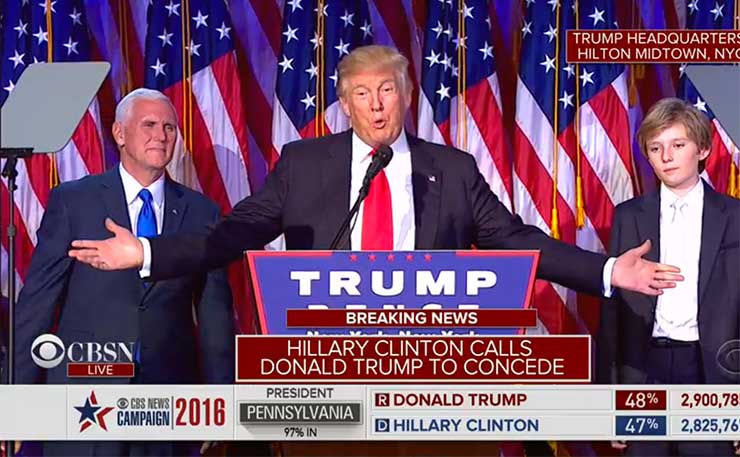
I will try to explain the fallacy in another way. 55 per cent of voters from 18-29 backed Clinton. 53 per cent of voters 45 and older got the support of Trump. Does this mean the election was solely decided by age? That old people are awful and reactionary, and young people are good and wonderful? Was that the basis on which the election was fought? Or is that simply one prism through which the campaign manifested itself? In my view, we should accept the latter.
Any particular demographic that voted for the Republican candidate in this election is a snapshot. To understand how Trump won, we have to understand what changed between him and previous candidates.
No one denies that Trump engaged in crudely racist rhetoric, and attracted many racist supporters. Yet what was the impact of this on his election?
When it comes to Hispanic voters, the gap between Democrats and Republicans narrowed. As noted at Pew Research, Clinton’s share of the Latino vote was lower than Obama’s in 2012. 71 per cent of Latinos backed Obama, whilst 27 per cent backed Romney – a margin of 44 per cent. 65 per cent of Latinos backed Clinton, whilst 29 per cent backed Trump. That is, Latino support for the Democrat declined, and Latino support for the Republican increased.
Likewise for black voters. And Asians. Their level of support for Clinton declined from their support for Obama in 2012.
What was different about Trump’s support?
Some 48 per cent of those earning over $100,000 a year voted for Trump. He narrowly beat Clinton in this demographic by 1 per cent. Traditionally, the rich vote for Republicans.
His support among the rich declined by 6 per cent since Romney ran in 2012. For those earning between $100k and $200k, Trump won by 1 per cent. Clinton improved on Obama’s vote among this demographic by 9 per cent. That is, Clinton significantly improved the standing of the Democrats among the affluent. Trump only narrowly won the vote of those earning between $200k and $250k by 1 per cent.
Yet Trump took white workers without a college degree by 67 per cent, to Clinton’s 28 per cent. Trump also held on to a narrow majority of white college graduates. Yet there were major changes in both categories – Clinton got 10 per cent more of white college graduates, whilst Trump improved over Romney’s standing with non-college graduates by 14 per cent.
Let me underline this: Clinton significantly improved the Democrat’s support among the affluent, whilst Trump significantly improved the Republican’s support among the working class.
Trump’s appeal to non-college graduate white voters played a particularly strong role in winning him the election. Taking the Upper Midwest – the Rust Belt – was what he needed, and what he did. The counties that backed Obama twice and then backed Trump were 81 per cent white. Those that backed Obama once were 71 per cent white. On average, 36 per cent of voters in counties Trump won had no college education. They gave him at least 83 electoral votes in Wisconsin, Iowa, Pennsylvania and Ohio. Perhaps more in Michigan and New Hampshire.
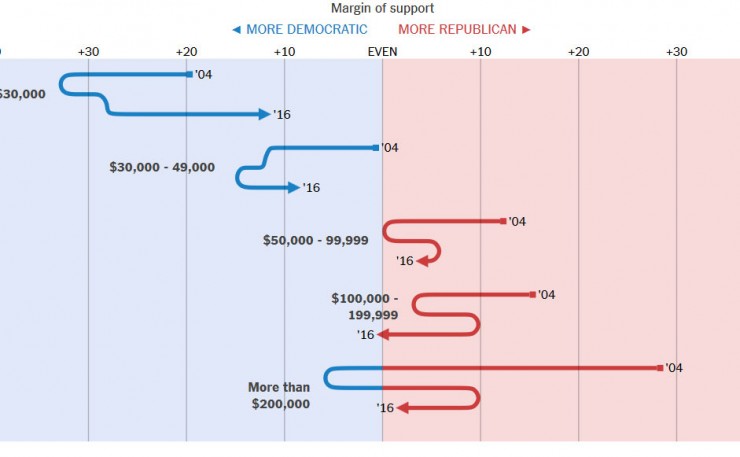
Have a look at how margin of support has varied by income. Trump got less support among the top three income groups than Romney did. But among those earning less than $50k a year – especially those earning less than $30k – Trump drastically improved his standing. He still only got 41 per cent of those earning under $30k, and 42 per cent of those between $30k and $49k. Yet these represented drastic improvements of 16 and 6 per cent.
That is the unusual thing about the election. Republicans usually win the super rich, the white, and the male. Trump did better among the poor and working class, registered better improvements among voters of colour than white voters in general, and only lost two per cent of women voters along the way – even though more women voted for Obama than they did for Clinton.
It wasn’t just white men who didn’t graduate college who supported Trump. Trump won white women by a margin of 10 per cent, with 53 per cent of their vote. He also garnered 62 per cent of non-college graduate women voters, as opposed to Clinton’s 34 per cent. Trump did even better with white men non-college graduates, winning 72 per cent of their vote, to Clinton’s 23 per cent.
Why would white working class, blue collar voters without college degrees be mad? Put aside the free trade agreements. The Economic Policy Institute has an array of graphs showing how wages have stagnated for American workers for decades. For the bottom 90 per cent, wages have increased 15 per cent since 1980.
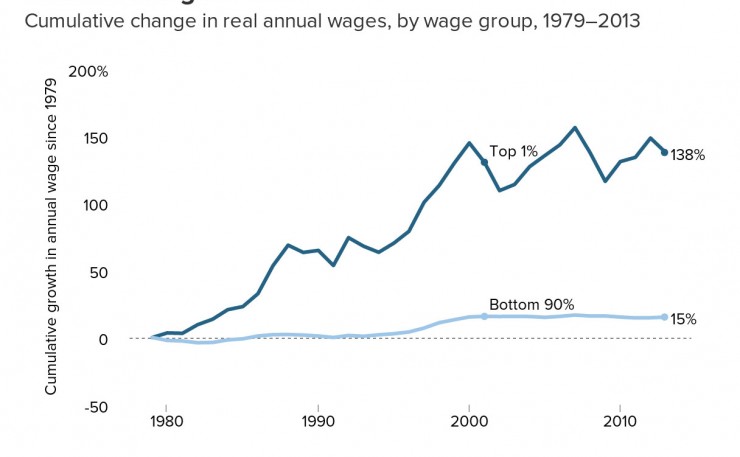
Low wage workers have seen their income decline by 5 per cent. The real minimum wage has declined since 1970.
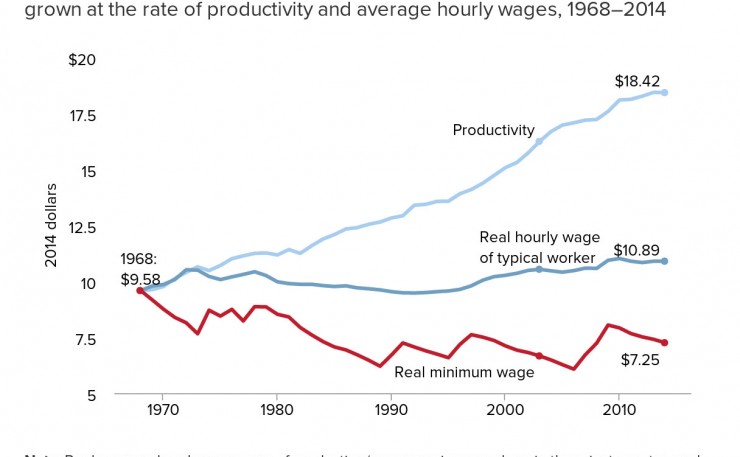
Torsten Bell from the Resolution Foundation notes another trend. That is, “many more people are neither working nor looking for work than was the case in the past. This partly reflects a failure in the US to bring women into the labour force in the way that has been done in much of Europe, but it is driven by more and more men dropping out of the world of work entirely.”
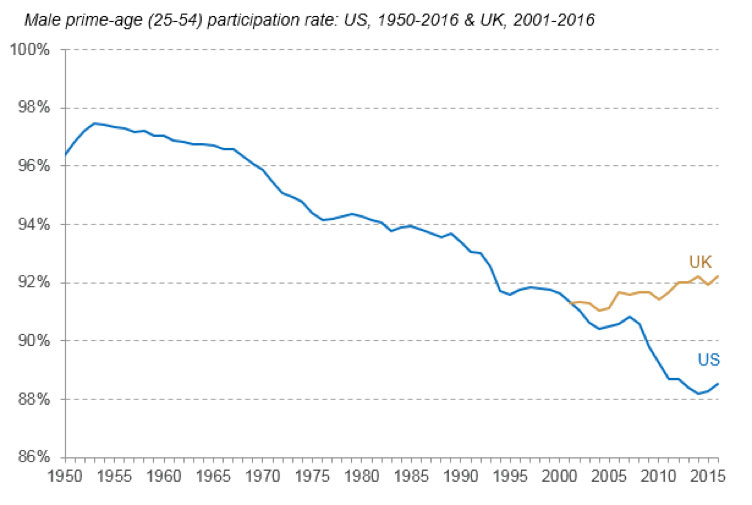
And in the rust belt states? Clinton got 13 per cent less votes than Obama, whilst Trump improved on Romney’s vote by 7 per cent. Clinton declined by about 20 per cent of the vote each in Iowa, Ohio, and by over 10 per cent of the vote in Wisconsin and Michigan. Trump did 9 per cent better than Romney in Pennsylvania and Iowa, and 7 per cent better in Michigan. Trump’s victories consisted not only of improved votes for himself, but also of declining support for the Democrats.
Conclusion
Republicans usually win over rich white men. Democrats usually do better among minorities, women, and in theory, those less well off economically. Yet Trump successfully reinvented the Republicans as the party of the working class, blue collar whites, male and female.
There is no reason the Democrats can’t reach these voters. The fact that Clinton lost whites who didn’t graduate college by almost 40 per cent shows the extent to which the Democrats have failed to develop a class politics that can appeal to those angry about stagnating wages and unemployment.
Instead of reaching out to blue collar and working class whites, Clinton drastically improved her standing among affluent whites. In the process, she alienated the voters of colour who stayed home, and the Rust Belt states that had twice voted for Obama, and now backed Trump.
Trump didn’t win a particularly large number of votes. He won fewer than Clinton, fewer than Romney, and fewer than McCain. He was simply shrewd enough to win enough votes in the Rust Belt states, among white blue collar workers, among communities that had plenty of reason to be sick of the establishment. And in an environment where most Americans thought the system was rigged for the rich and powerful, Clinton bragging about her experience marked her as an insider.
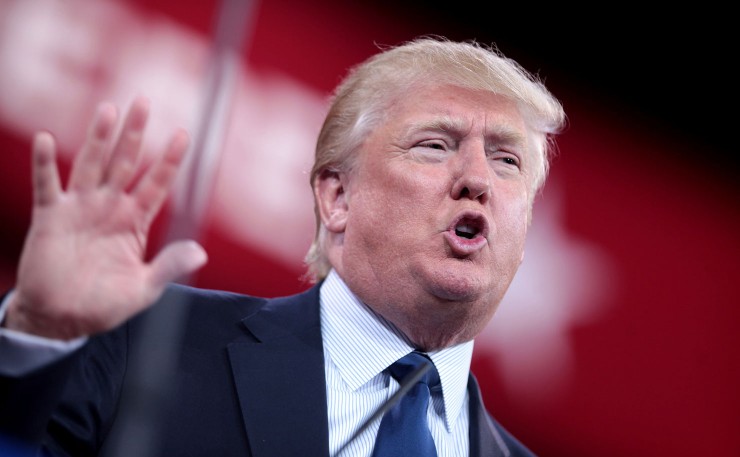
The losers of American capitalism were desperate for change. They haven’t enthusiastically backed Trump. They have, sceptically, given him a narrow victory. Trump is not invincible, and the American people have not fundamentally changed.
It is hard to separate Trump’s appeal to white workers from his crude racism and sexism. After all, his support was particularly strong among white people, and particularly strong among white men. But it was above all strong among blue collar white men, and it was his ability to successfully target them that won him the election.
In this sense, the role of race and gender in the election is complex. Undoubtedly, they were there. Trump ran an overtly racist campaign as a crude sexist. But his appeal through race and gender are inseparable from his appeal on a class basis. If the Democratic nominee had kept Obama’s voters of colour, or had appealed to poorer whites rather than wealthy ones, then the result may have been quite different. Clinton failed to do so, but that doesn’t mean that Trump is invincible.
Stressing the role of class in the election is important. Because just as Trump was able to peel away blue collar workers from the Democrats, so the Democrats could take them back.
The challenge in the meanwhile for Americans is to develop a social democratic alternative to Trump. As for the rest of us, we can only watch anxiously, and hope Trump doesn’t destroy the planet.
Donate To New Matilda
New Matilda is a small, independent media outlet. We survive through reader contributions, and never losing a lawsuit. If you got something from this article, giving something back helps us to continue speaking truth to power. Every little bit counts.

